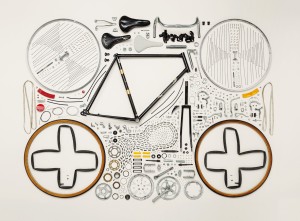I’ve had the pleasure of working with 2 fantastic colleagues, Zach Strother and TJ Edwards, on an Interdisciplinary PBL “Unit”. TJ had the idea of HMW we redesign a bike for an urban commuter that he wants to use in his Tech, Engineering, and Design (TED) class. Zach teaches AP Physics. I teach Algebra 2. As I left our time of collaboration this morning, I reflected on how fortunate I am to work with these guys, how well we work together, and how learning from them is making me a better math teacher, which benefits my students. Part of what works in our collaboration is that we chose the project and each other. We come from similar mindsets to education, though not identical, which probably minimizes the disagreements. Yet, we also feel comfortable enough to push back on certain things and talk through disagreements as we get to unity.
This started when I was at NCTM Boston in April. I noticed a lack of Design Thinking at the conference. I emailed TJ & Zach before I even left Boston asking if they wanted to put together a proposal for the NCTM 2016 conference. And oh, by the way, proposals are due on or before May 1. They both were in and when I returned to the ATL, we got to work. TJ already had the idea of the bike redesign. We worked together as to how we would lead a conference session through parts of the DT process, while also sharing the results of how we implemented the project at our own school. Proposal submitted on exactly May 1 and now we await word if it will be approved.
Zach suggested we apply for summer grant work from our independent school as they were wanting teachers to create interdisciplinary projects. TJ submitted that proposal, we were approved, and so we have spent time this summer creating the UbD plans for our individual courses, times when we will have the students together, rubrics, and the timeline for the whole project. (My Alg 2 UbD plan is here.)
It was chance that my CP Algebra 2 class is the same period as Zach AP Physics. We don’t have any students in common, and we think that makes it better. TJ’s class will start the DT process with interviewing users (empathy) & 3 bikes, then fill in a project brief to hand off to the AP Physics students.
Zach will have some labs pre-designed, but also have the students design 1 lab from scratch based on the needs of the TED students. The Alg 2 students will do the labs with the Physics students, take the data back to work on in our classroom, and then fill in the project brief with their results. The AP Physics students, who are further along in their math career than the CP Alg 2 students, will give feedback on the math to my students! I love students getting directions and then feedback on the results from other students. After all of our labs, the project brief goes back to the TED students for iteration.
We will each be assessing our students on our specific content learning outcomes, content area processes (for example, in math the Standards of Mathematical Practice), and then we picked two of our school’s Mindsets – Collaboration & Communication. We used BIE’s Collaboration & Presentation rubrics as a guide and merged/changed the pieces we wanted to focus on for this project. So, all students will be self-assessing, peer-assessing, and have teacher-assessing done on the mindsets using the same rubric across all 3 classes. Additionally, we’ve picked 3 times during the 1st semester where we will get all students together so that they can give each other in person feedback, not just on the planning brief.
I’m excited. I’m excited for my students to see how the things we do in Algebra 2 get applied in other disciplines. I’m excited to do physics labs! I’m excited to learn how to bring more science into my classroom. I’m excited for my students to be a part of a project and realize that they don’t have to be involved in every aspect – much like teams in various occupations – they pass the baton. I’m excited that I’m finally doing something like this in my classes.
Thanks MV for giving us the grant to make this happen and trusting us to meet both our content learning outcomes & the MV mindsets.

Pingback: Purpose-Based Learning (A Fail Up Moment) | The Mount Vernon Continuum
Pingback: Purpose Based Learning (a #FailUp moment) | Planting T’s | Mount Vernon Institute for Innovation
Pingback: Not All at Once | The Life of Pinya
Pingback: Purpose Based Learning (a #FailUp moment) | Planting T's
Robin, this is very exciting. I love the introduction to the emerging story that you provide. I also talked to TJ on Friday and heard from his perspective, too. I am grateful and elated by your trio’s dedicated work and commitment to each other, to the student learners, and to the cause of exploring the interdisciplinarity of DT and PBL. We are so fortunate to be in this culture and practice of inquiry, innovation, and impact. And MVIFI is proud to support this work that your team is doing!
LikeLike
Hey Bo, thanks for your feedback! I was telling Jim that I’m at the point that I want to really work on lesson plan and design, yet have 1.5 weeks left in my summer classes. 6 more papers to write and then I can dig in even more to how I’ll be implementing in my classroom. 🙂
LikeLike
Reblogged this on it's about learning and commented:
An enticing introduction to a great story of collaboration among educators and colleagues, made possible by their vision and action, with support from our school and the Institute for Innovation. Look forward to learning more as this experimenting and building journey emerges in the fall.
LikeLike